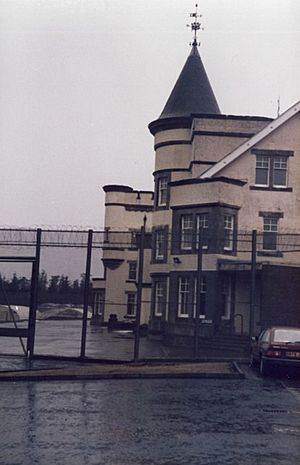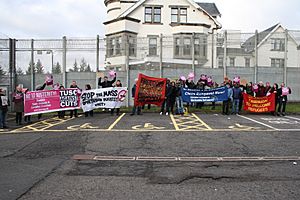Dungavel facts for kids
Dungavel Immigration Removal Centre is a special facility in South Lanarkshire, Scotland. It is close to the town of Strathaven. People sometimes call it Dungavel Castle or Dungavel House. This centre holds people who are waiting for decisions about their right to stay in the United Kingdom.
Mitie Care and Custody runs Dungavel. They work for Immigration Enforcement, which is part of the UK government's Home Office. Dungavel is the only centre of its kind in Scotland. In 2016, it was announced that Dungavel would close. However, this plan was changed in 2017, and the centre stayed open.
History of Dungavel
Dungavel started as a large hunting lodge in the 1800s. It was a summer home for the Dukes of Hamilton. Their main home, Hamilton Palace, was later taken down because of mining damage. So, the 13th Duke moved into Dungavel in 1919.
In 1941, during World War II, Rudolf Hess flew to Scotland. He hoped to meet the 14th Duke of Hamilton at Dungavel. Hess wanted the Duke to help him talk to Winston Churchill about ending the war between Britain and Germany. This mission did not go as planned.
Dungavel was sold in 1947 to the National Coal Board. Later, the government bought it and turned it into a prison. In 1979, Agnes Curran became the governor of Dungavel prison. She was the first woman to be in charge of a prison for men in Britain. She was surprised by the job and had to deal with how male staff and prisoners saw a woman governor. She received an award in 1984 for her work.
In 2001, Dungavel's role changed. It became a place for holding asylum seekers whose requests to stay in the UK had been turned down. These people stay there before they are asked to leave the country. The 13th Duke of Hamilton, who was a naval officer, is buried near the castle. His grave once had a ship's anchor on it.
What Dungavel is Used For Now
Dungavel became an immigrant detention centre in 2001. The company Mitie Care and Custody manages it. In 2013, the centre was made bigger. It can now hold 249 people, both men and women, in four main living areas.
There have been many protests about Dungavel. People are concerned because babies and young children have been held there. Sometimes, families have been kept for over a year before being asked to leave the country. For example, the Kurdish Ay family, with four children aged 7 to 14, stayed in one room at Dungavel for 13 months. They later found safety in Germany.
In 2003, lawyer Aamer Anwar led a campaign about the Ay family's detention. He has continued to ask for Dungavel to be closed. He calls it "inhumane and barbaric" and a "scar on the face of Scotland." In 2012, the UK government agreed to pay the four Ay children a large sum of money. This was after they took legal action for their time in detention.
In 2004, the Children's Commissioner for Scotland said the centre was "morally upsetting." He even threatened to report the UK and Scottish Governments to the United Nations. This was because of concerns about children's rights. However, the former Home Secretary, David Blunkett, said that holding people is needed for immigration control. He also said it was better for children to stay with their parents than to split up families.
The Scottish Government does not directly control Dungavel. This is because asylum and immigration rules are set by the UK Parliament. But Scottish officials kept pushing for changes at the centre. They used their power over child welfare matters. After the 2010 UK General election, the UK Coalition government said it would stop holding children under 18 at Dungavel. At first, it seemed this meant children would no longer be held in Scotland. However, they were often moved to Yarl's Wood Immigration Removal Centre in Bedfordshire. This centre also had its own issues and held children for long periods.
Public Concerns
Groups like Detention Action and the Scottish Refugee Council have criticized Dungavel. They believe that human rights have been broken there. In 2015, inspectors from Her Majesty's Inspectorate of Prisons (HMIP) found problems. They reported that people who were vulnerable were being held there. This went against rules designed to protect such individuals from detention.
See also





